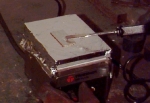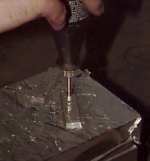S-BOND TECHNOLOGY
Soldering Joining Process
S-Bond alloys enable low temperature solder bonding enable a metallic bonding solution for thermally sensitive components. The specific soldering joining process to use S-Bond Technologies’ active solder materials depends on the substrate materials, the joint geometry, and the production volume. In general, the process flow is to:
- Bring the component parts to the proper joining temperature;
- Using mechanical activation / agitation (usually brushing, scraping, or ultrasound), uniformly coat the joining surfaces of the parts;
- Using additional solder material to ensure a completely filled joint, bring the surfaces together with additional shear (usually sliding the parts relative to each other or ultrasound);
- Clamp or hold the parts during cooling to maintain position and prevent the joint from spreading due to the surface tension of the solder material.
This general process applies to any metal or ceramic, with the resulting joint strength varying from 20-55 MPa (3-8,000 psi). Higher joint strengths in carbon based substrates (e.g. diamond, thermal pyrolytic graphite, foamed graphite), stainless steel, Kovar®, and other high performance materials are achieved by replacing the initial coating step with a proprietary heat treatment process that ensures a permanent chemical bond to the material surface. It may also be possible to skip the surface precoating steps, depending on the geometry of the bond area and the substrate materials.
Variations of this generic process are practiced today in the production of thermal management devices, sensor housings, and sputter targets. A process for semi-automated joining using a multi-station carousel has also been demonstrated.
Please Contact Us if you need further information or help in defining the best process for your application, or see Products for more information about specific products.
Joining Methods

S-Bond materials are placed onto surfaces by various means of mechanical agitation, also termed “activation”, as shown in the figures below. This first figure shows how the S-Bond alloy is transferred without flux to aluminum, using a rubbing process, while the S-Bond alloy is molten on the part surfaces, Transfer to many different geometries, tubes, flanges, edges can easily be adapted using various tools and techniques. Feel free to Contact Us to consult on the best techniques for joining your components.

Brushing is another way to transfer S-Bond to joining surfaces. It is particularly effective on irregular surfaces and foam surfaces.

Ultrasonic application effectively agitates S-Bond alloys onto component surfaces. The horn tip does not normally touch the part surface and relies on cavitation driven by the 20 – 30kHz acoustic waves to mechanically activate and break up the oxides that form on the molten S-Bond layers. This method is particularly well suited to automation and preparing large flat surfaces for S-Bond joining.
Contact us with any questions about the soldering joining process or our services today.
More Information?
If you would like someone to contact you or provide information, please submit the information below.
